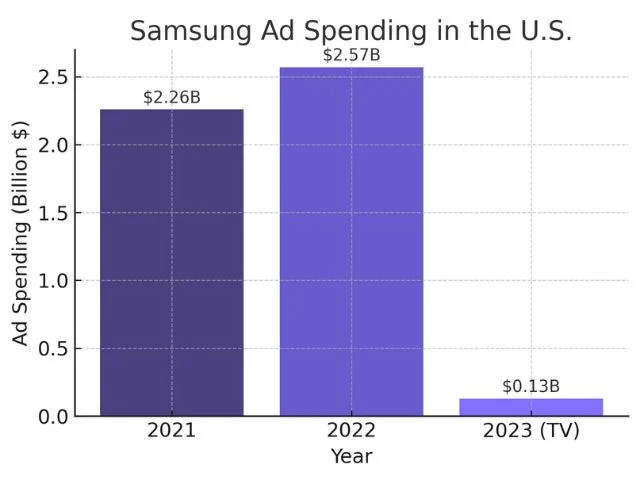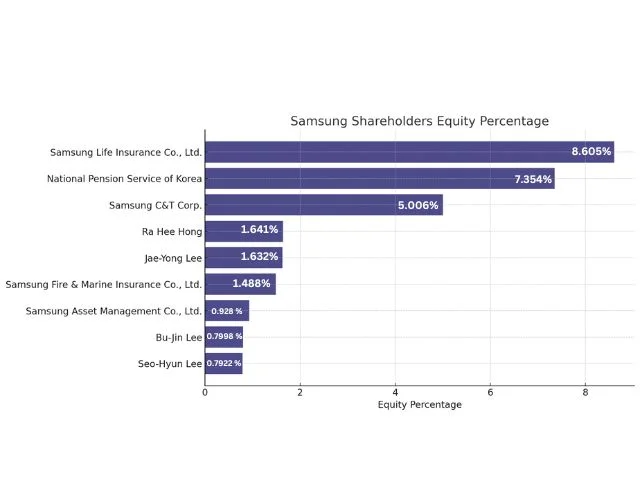by Abdullah Faraz
March 4, 2025
Approximately 12.82% of the world’s population uses Samsung devices. Samsung users are continually increasing due to their products’ quality, variety, branding, and innovations as technology evolves.
Samsung currently has 1.033 billion active users around the world, while the total number of smartphone users is 7.41 billion. These numbers show that Samsung has a hold on a large portion of the mobile phone industry.
If you are looking for the latest stats about Samsung, then this article is a goldmine for you as I have gathered all the interesting stats in one place.
Let’s start mining….
- Samsung Stats (Top Picks)
- Samsung’s Market Share and Revenue
- Samsung’s Financials and Business Performance
- Samsung’s Corporate Information
Key Samsung Stats
- 12.82% of the world’s population uses Samsung devices.
- Samsung has 1.033 billion active users worldwide.
- Samsung holds a 23.61% global smartphone market share, making it the second-largest smartphone manufacturer after Apple.
- Apple leads with a 27.81% smartphone market share, just ahead of Samsung.
- Samsung’s TV market share in 2024 was 28.3%, maintaining its No. 1 position since 2006.
- Samsung’s tablet market share was 18% in Q3 2024, securing the second position behind Apple.
- Samsung holds only 2% of the global laptop market, competing with Toshiba, MSI, and Microsoft.
- IDC reports Apple has a 23.5% smartphone market share, while Samsung has 15.7% in 2024.
- Counterpoint claims Samsung had a 19% smartphone market share in 2024, while Apple had 18%.
- Samsung’s revenue in 2024 was $219.17 billion, up from $196.77 billion in 2023.
- Samsung’s highest-ever annual revenue was $240.71 billion in 2021.
- Samsung’s total net worth in 2025 is $246.17 billion.
- Samsung Ads generate between $100 million and $1 billion annually.
- Samsung spent $2.57 billion on advertising in the U.S. in 2022.
- Samsung’s TV ad spending in 2023 was $128.74 million in the U.S. alone.
- Samsung has 267,860 employees worldwide, with more than half working overseas in 76 countries.
- Samsung Life Insurance Co., Ltd. owns 8.605% of Samsung Electronics, making it the largest shareholder.
- Samsung was founded in 1938 in Taegu, South Korea, making it 87 years old in 2025.
- Samsung manufactures most of its smartphones in Vietnam, with additional production in India, South Korea, Brazil, Indonesia, and China.
- Samsung has remained the top TV manufacturer for 19 consecutive years.
Samsung’s Market Share and Revenue

What is the global market share of Samsung?
As of 2025, the global market share of Samsung is 23.61%, making it the second-largest mobile phone manufacturer in the world behind Apple, which has a 27.81% market share. Samsung is also a leader in the tablet, display, and semiconductor industries.
Source: Statcounter
What is the market share of Samsung TV?
Samsung not only has a big market share and name in the smartphone industry but also contributes a large portion to the television market. In 2024, Samsung’s market share in the TV industry was 28.3%. It has maintained the number-one ranking since 2006, growing for 19 years.
Source: Tahawultech
What is the share of the Samsung tablet market?
Although Samsung’s market share in tablets varies slightly depending on the quarter and source, the market share of Samsung tablets in the third quarter of 2024 was 18%. Overall, Samsung is the second-largest tablet vendor globally, consistently holding a significant market share behind Apple.
Source: Statista
What is the share of Samsung laptops market?
Samsung’s share of the global laptop market is around 2%, which is relatively small compared to other major brands. Samsung, along with brands like Toshiba, MSI, and Microsoft, collectively holds about 13.7% of the global laptop market share.
Source: Fortunly
What is the market share of Apple vs Samsung?
The market share of Apple and Samsung in the global smartphone market varies slightly depending on the source. Here are some recent figures:
- According to Counterpoint, Samsung’s market share in 2024 is 19%, while Apple’s market share is 18%, decreasing by 2% YoY.
- IDC reports show that Apple has a market share of 23.5%, while Samsung has 15.7%, but both have seen a decrease YoY.
- As of 2025, Samsung’s global market share is 23.61%, making it the second-largest mobile phone manufacturer behind Apple, which has a 27.81% market share, according to Statcounter.
Samsung’s Financials and Business Performance
What is Samsung yearly revenue?
Samsung Electronics’ global revenue has significantly increased from 2010 to 2024. In 2024, Samsung’s revenue reached $219.17 billion, compared to $196.77 billion in 2023.
| Year | Revenue (in Billions) |
| 2010 | 133.94 |
| 2011 | 146.43 |
| 2012 | 184.22 |
| 2013 | 210.86 |
| 2014 | 195.22 |
| 2015 | 174.66 |
| 2016 | 175.51 |
| 2017 | 214.57 |
| 2018 | 221.67 |
| 2019 | 198.03 |
| 2020 | 203.43 |
| 2021 | 240.71 |
| 2022 | 233.13 |
| 2023 | 196.77 |
| 2024 | 219.17 |
Source: Statista, Companiesmarketcap
What is Samsung’s total net worth?
As of 2025, the total net worth of Samsung is $246.17 billion. It includes both market capitalization and net assets. Samsung’s net worth can fluctuate based on market conditions and financial performance.
Source: Companiesmarketcap
What is the annual revenue of Samsung ads?

The annual revenue potential of Samsung Ads ranges from $100 million to $1 billion. This shows that Samsung’s ad network is highly beneficial for brands. This is an established ad system; even two decades ago, big companies like Flipboard used to advertise with Samsung.
Source: Leadiq
How much does Samsung spend on advertising a year?
In 2022, Samsung spent approximately $2.57 billion on advertising in the United States, up from $2.26 billion in the previous year. In 2023, Samsung’s highest ad spending in the United States was on television media, reaching $128.74 million.
Source: Statista
Which segments are Samsung’s largest revenues derived from?
Samsung’s largest revenue segments include:
Mobile Communications (MX): This segment includes smartphones, tablets, wearables, and related accessories.
Semiconductors: Samsung’s semiconductor division manufactures DRAM and NAND flash memory chips, etc.
Consumer Electronics: This segment includes products like TVs, air conditioners, refrigerators, and other domestic devices.
Display Panels: Samsung also generates substantial revenue from the production and sale of LCD and OLED displays used in various electronic devices.
Samsung’s Corporate Information
Is Samsung from China or Japan?
Samsung is neither a Chinese nor a Japanese company. It is the largest chaebol (business conglomerate) in South Korea.
Are Samsung products made in the USA?
Some Samsung products are made in the United States, but the majority are manufactured elsewhere. Samsung operates a home appliance manufacturing facility in Newberry County, South Carolina, which began production in 2018.
Samsung Semiconductor, Inc., is based in Silicon Valley but does not manufacture chips directly in the U.S.
Most Samsung smartphones and tablets are manufactured in Vietnam, India, South Korea, Brazil, Indonesia, and China.
Sources: Samsung Newsroom, Android Authority, Samsung
How many employees does Samsung have?
As of 2025, according to the Samsung Newsroom, Samsung has 267,860 employees, with more than half working overseas in 76 countries.
Who owns the majority of Samsung?

Samsung’s ownership structure is complex, with no single entity holding a majority stake. Major shareholders include:
| Samsung Shareholders | Equity Percentage |
|---|---|
| Samsung Life Insurance Co., Ltd. | 8.605% |
| National Pension Service of Korea | 7.354% |
| Samsung C&T Corp. | 5.006% |
| Ra Hee Hong | 1.641% |
| Jae-Yong Lee | 1.632% |
| Samsung Fire & Marine Insurance Co., Ltd. | 1.488% |
| Samsung Asset Management Co., Ltd. | 0.928 % |
| Bu-Jin Lee | 0.7998 % |
| Seo-Hyun Lee | 0.7922 % |
Source: Marketscreener
How long has Samsung been around?
Samsung was founded in 1938 by Lee Byung-chul in Taegu, South Korea, making it 87 years old as of 2025.
Initially, it started as a trading company before expanding into various industries, including electronics, which it became globally known for in the late 20th century.
Conclusion
Here are all the interesting and latest stats about Samsung in one place. Samsung has maintained its position in the market while competing with both old and new competitors like BlackBerry, Apple, and Xiaomi. Apple is its biggest competitor, but Samsung still holds a strong market presence.